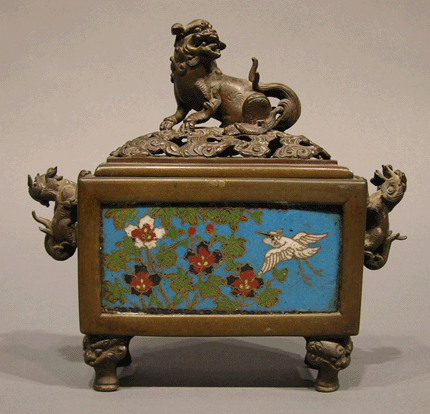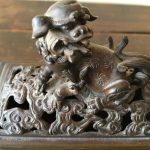
Early-to-mid 18th C. Bronze with enameled cloisonné; lively sculpted bronze Fu-dogs and dragon heads. 7.5″h, 8″ w, 3″ d.

This rare incense burner is made of bronze and has an insert of cloisonné panel on opposite sides of the body. The burner is distinguished by a metal domed-lid topped by a big, superbly sculpted fierce-looking bronze Fu-dog perched on a sea of openwork clouds that take on the shape of the “lingzhi” (the sacred fungus symbolizing longevity and immortality), two equally lively small Fu-dogs climbing the sides as handles, and four dragon heads as legs. The Fu-dog is the protector of the god Fu, and the emblem of valor and energy.
Each long side of the rectangular box have inserts of cloisonné panels decorated with scenes of flowers and birds. One panel shows a phoenix perched on a paulownia tree (once known in China as The Princess Tree as it takes on the name of a past Russian princess), and the other panel a crane flying towards a peony bush. These are emblems of nobility. The light blue cloisonné enamel surface has a matte finish and shows tiny dark pits which are caused by gas escaping from the bronze during firing. This is a characteristic of early enamelware when the technique of firing was not perfected. Inside the box are two short wood rods stretching half-way up the sides for the purpose of holding up a dish or sticks of incense.
This incense burner is deemed rare because with its beautifully adorned bronze figures of lion-dogs and dragon heads, and inserted with cloisonné panels enameled with royal attributes, it was likely made for a member of the extended royal family. Like most religious vessels made for worship and not for celebrating a monarch’s reign at that early period, this incense burner does not have a reign mark. (Noted in “Chinese Cloisonne: The Pierre Uldry Collection”). Its age is attributed to early to mid-18th century because of the characteristic primary colors used during Emperor Kangxi period. It came out of China with a descendent of three generations of missionaries in the 1990s and was in private collection until it came into our collection.